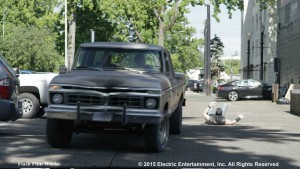
Visual effects artists at Hollywood-based Flash Film Works recently relied on Blackmagic Design’s Fusion Studio to create extensive VFX shots for TNT’s new weekly sci-fi series The Librarians.
The Librarians centers on an ancient organization that sets off on a variety of adventures in an effort to solve impossible mysteries, fight supernatural threats and recover powerful artifacts, including the Ark of the Covenant, the Spear of Destiny and Excalibur. To capture the action, the show requires a large number of effects each week, which are created by Flash Film Works’ Jeremy Nelson and his team using Fusion Studio.
The software’s feature set allows them to quickly and efficiently build and finalize a huge number of complicated shots, such as creating damage on a car, a magical teleporting membrane and an evil minotaur chasing the librarians and punching through a heavy metal door.
“Using Fusion, we did an object track of the minotaur’s face and created his glowing evil demon eyes by projecting them on Fusion spheres,” explained Nelson. “The team set up the original spheres in 3D and then finished them using the glow nodes and color correction, all in Fusion. At this point, 3D guys can comp their own stuff in Fusion. That’s been my catch phrase: ‘I think I can just do that in Fusion, so you don’t need to.’”
“For the membrane scene, the characters walk through a door and pass through the membrane, which pops, and they go through another dimension,” said Nelson. “In Fusion, I set up the shot to do a 3D roto, rendered the roto a frame or two and then projected my roto onto the geometry, and it was done. Quick and simple.”
Another complex VFX shot was a crash scene with damage to the front of a car. “I did this completely in Fusion working on a 3D track,” Nelson said. “I set up a projection, and we created the damage to the front end of the car using the displace 3D node. We took a frame of the car, displaced it with a displace node and lit it to get the shadows. We then projected it onto geometry, which is the image of the car on that displaced geometry that’s been 3D tracked on the car.”
“Before Fusion developed its capture node, I would have to render it out and import it back into Fusion. Without that extra step, and now being able to roto what you are projecting or do a quick paint on something, it is amazing,” he concluded. “For the car shot, we did it in a few versions, but it was almost complete at the first go. Fusion gave us the technical result quickly, and the rest of the notes were just artistic changes, not technical errors.”





